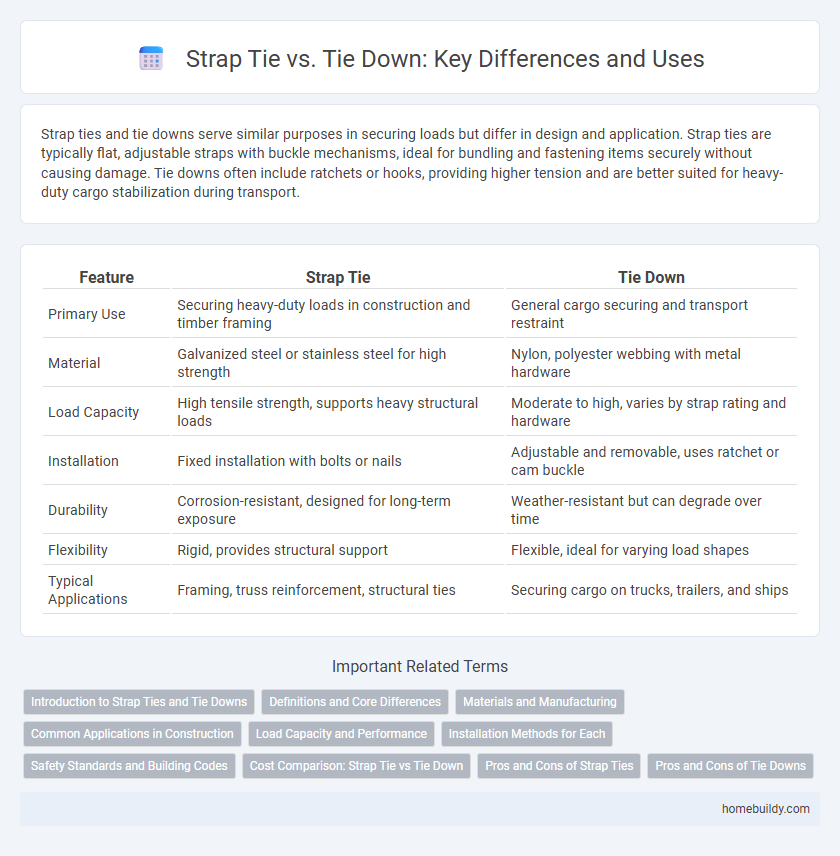Strap ties and tie downs serve similar purposes in securing loads but differ in design and application. Strap ties are typically flat, adjustable straps with buckle mechanisms, ideal for bundling and fastening items securely without causing damage. Tie downs often include ratchets or hooks, providing higher tension and are better suited for heavy-duty cargo stabilization during transport.
Table of Comparison
| Feature | Strap Tie | Tie Down |
|---|---|---|
| Primary Use | Securing heavy-duty loads in construction and timber framing | General cargo securing and transport restraint |
| Material | Galvanized steel or stainless steel for high strength | Nylon, polyester webbing with metal hardware |
| Load Capacity | High tensile strength, supports heavy structural loads | Moderate to high, varies by strap rating and hardware |
| Installation | Fixed installation with bolts or nails | Adjustable and removable, uses ratchet or cam buckle |
| Durability | Corrosion-resistant, designed for long-term exposure | Weather-resistant but can degrade over time |
| Flexibility | Rigid, provides structural support | Flexible, ideal for varying load shapes |
| Typical Applications | Framing, truss reinforcement, structural ties | Securing cargo on trucks, trailers, and ships |
Introduction to Strap Ties and Tie Downs
Strap ties and tie downs are essential components for securing loads and providing structural support, with strap ties primarily used in construction to fasten wood framing, while tie downs are designed for anchoring heavy equipment and cargo. Strap ties are made of galvanized steel or heavy-duty metal and are engineered to resist tension and uplift forces in building frameworks. Tie downs, often equipped with ratchets or hooks, offer adjustable tensioning capabilities ideal for transportation and outdoor applications.
Definitions and Core Differences
A strap tie is a fastener typically used in construction to secure wooden framing members, providing structural reinforcement by linking joists, rafters, or studs. A tie down, on the other hand, refers to devices designed to anchor objects, equipment, or loads, often using straps or cables to prevent movement during transport or in high winds. The core difference lies in their application: strap ties serve as integral components within building frameworks for stability, whereas tie downs focus on external load restraint and securing cargo.
Materials and Manufacturing
Strap ties are typically made from galvanized steel, providing enhanced corrosion resistance and durability compared to standard steel tie downs often constructed from plain steel or polyester webbing. Manufacturing processes for strap ties involve precision stamping and galvanization, ensuring consistent load-bearing performance and long-term structural integrity. In contrast, tie downs may utilize simpler fabrication methods, which can result in varied strength and lifespan depending on the materials used.
Common Applications in Construction
Strap ties are primarily used in construction to reinforce wood framing connections and provide shear resistance, especially in wall and roof assemblies. Tie downs serve to anchor structures to foundations, preventing uplift and lateral movement during high winds or seismic activity. Both are essential for structural stability but are chosen based on whether the application requires internal frame reinforcement or external anchoring.
Load Capacity and Performance
Strap ties offer enhanced load capacity compared to traditional tie downs, providing superior strength and durability for securing heavy loads. Their design incorporates reinforced materials that distribute tension evenly, reducing the risk of slippage and failure under high stress. Performance-wise, strap ties maintain reliable tension and stability in dynamic conditions, making them ideal for industrial and transportation applications requiring robust load management.
Installation Methods for Each
Strap ties are typically installed using nails or screws directly into wood framing, providing a rigid, hardware-based connection essential for structural reinforcement in construction. Tie downs often require anchoring to concrete or steel using bolts or specialized fasteners, designed to resist uplift and lateral forces in securing heavy loads. Installation methods for strap ties emphasize ease of integration with wooden structures, while tie downs focus on secure anchorage to diverse surfaces for maximum load retention.
Safety Standards and Building Codes
Strap ties and tie downs differ significantly in their compliance with safety standards and building codes, with strap ties commonly meeting ASTM D5687 requirements for load resistance and corrosion protection in structural applications. Building codes such as the International Residential Code (IRC) specifically reference strap ties for their effectiveness in resisting uplift and lateral forces in wood framing, providing critical reinforcement at connections. Tie downs must be verified against these standards to ensure proper performance and code compliance, but strap ties often offer superior engineered solutions for seismic and wind load conditions.
Cost Comparison: Strap Tie vs Tie Down
Strap ties typically offer a lower initial cost compared to tie downs, making them a budget-friendly option for securing loads in construction and transportation. Tie downs often incorporate more durable materials and adjustable features, which can drive up the price but provide enhanced safety and reusability. Evaluating long-term cost-effectiveness requires considering the frequency of use, load types, and maintenance expenses associated with each securing method.
Pros and Cons of Strap Ties
Strap ties offer superior flexibility and ease of adjustment compared to traditional tie downs, making them ideal for securing irregularly shaped loads. Their lightweight design reduces overall cargo weight but may compromise strength under extreme tension or heavy loads. Unlike tie downs, strap ties are less likely to damage sensitive surfaces due to their broader contact area, though they typically lack the heavy-duty durability required for industrial applications.
Pros and Cons of Tie Downs
Tie downs offer superior versatility for securing loads due to adjustable tension and multiple anchor points, making them ideal for irregular or heavy cargo. However, tie downs can be more complex to use, requiring proper knowledge to avoid load shifting or damage. Their durability varies by material, with ratchet straps providing higher strength but increased risk of over-tightening compared to simpler strap ties.
Strap tie vs tie down Infographic

 homebuildy.com
homebuildy.com